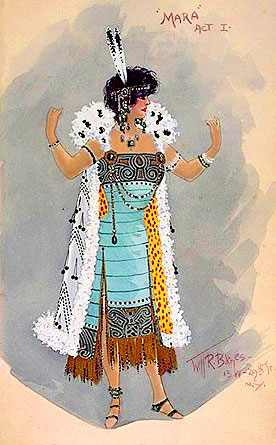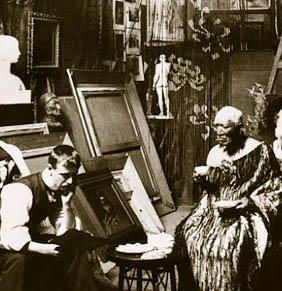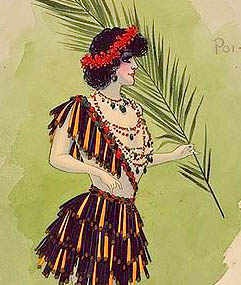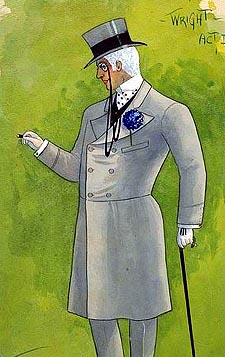Maori Songs - Kiwi Songs - Home
Mara
was the heroine of "Tapu", the 1903 comic opera about Victorian
travellers in
a pre-European Maori pa near Mt Tarawera But Hill only wrote this
international hit
hit song a year later, while watching a mouse in
Goldie's portrait studio in Auckland.
Anna Hato
singing in 1927

Touch each costume picture.
| Original English/Maori |
Later Maori version |
English translation of Maori |
| 1.
Mara, Maori maiden proud, Famed for poi play Far on winds her name is blown Dusky lithesome fay |
Tēnei rā e Māra e |
There's
Mara The lady of the poi. On the four winds her fame is blown. |
| Ki-a-ri-te,
ki-a-ri-te Poi po-ro-ti-ti ta-pa-ra pa-tu-a* Hei ha hei! Hei ha! Hei ha hei! Hei ha! |
Kia rite! kia rite! Poi porotiti tāpara patua! Hei ha hei! Hei ha! Hei ha hei! Hei ha! |
Keep in time! Keep in time! Now twist the poi and tap it twice! Hei ha hei! Hei ha! Hei ha hei! Hei ha! |
| Refrain
Watch her supple wrist, And the poi twirl and twist; Hear the gentle tapping, 'Gainst the raupo wrapping Of this fascinating thing, |
|
Here is her poi Swinging out, swinging back, listen to the sound of the raupo As it beats its rhythm |
| Tiny
ball on end of string, Of this fascinating thing, Tiny ball on end of string, Tiny ball! Tiny ball! Hei! Hei! Hei-ha! |
Runga
i ngā mahi nei A ō tatōu māua A ō tatōu tīpuna Tana poi! Tana poi! Hei! Hei! Hei-ha! |
In
accordance with the custom of our parents, of our ancestors, It's her poi! It's her poi! Hei! Hei! Hei! ha! |
| 2.
Mark the sound her piu-piu makes As her body moves; That it is enchanted flax Such sweet music proves |
Tēnei
rā ngā mahi nei |
Hear
now the swishing of her piupiu It is similar to the tapping of the poi, eh? |
| Kiarite,
kiarite Poi porotiti tapara patua* Hei ha hei! Hei ha! Hei ha hei! Hei ha! |
Kia
rite! kia rite! Poi porotiti tāpara patua! Hei ha hei! Hei ha! Hei ha hei! Hei ha! |
Keep
in time! Keep in time! Now twist the poi and tap it twice! Hei ha hei! Hei ha! Hei ha hei! Hei ha! |
|
|
*Alternative
English words are given in small print: Dusky, lithesome, fayColonial
English girls in Victorian times wore big hats and long
dresses, were kept in shape and out of bounds with corsets,
and were trained to be polite and "proper." So their skins
were snow-white, their movements constrained and their
behavior predictable. |
| Hill
spent much time in Charles
Goldie's Auckland studio, learning waita sung by
the painter's elderly Maori sitters, such as Patara Te
Tuhi shown here in 1901.
Fifty years afterwards, Hill recalled one evening in 1904. "Charlie Goldie had a studio in Shortland Street and he used to paint nothing but... old tattooed Maoris. When the light had gone... these old people used to sing to me half-remembered chants of the old days, and that's where I got most of my collection of Maori music... "However this night he went out to buy something, and while he was out I sat on a sofa and a little mouse came playing on the carpet. I watched for a while and suddenly the refrain of a poi came into my mind. When Charlie came back I said 'Charlie! Listen to this! I've got a worldbeater!' And I sang the refrain of the poi, words and music. It wasn't long before I had finished the whole song." Otago Witness, 6 Nov 1907"Miss Helen Gardner earned the most imperative encore of the evening for her rendering or Mr Alfred Hill's song, "Waiata poi," a very effective composition, aptly descriptive of the well-known Maori poi dance. The popularity of this little composition is easily assured." |
|
|
Evening
Post, 12 August 1908 Quite new, of course, to London was Mr. Alfred Hill's quaint and taking Maori song, "Waiata-Poi." The audience was immensely charmed with this, and they insisted on its repetition; the singer himself seemed thoroughly to enjoy singing it, and it went off with great gusto and spirit, to the accompaniment of the London Symphony Orchestra. His audience would have liked it again - after the second time of hearing they still clamoured for more |
 |
'Tapu' or a Tale of a Maori Pah
|
Mara,
a proud young Maori woman, was the heroine of
this comic opera dealing with Maori life and Maori
customs. |
|
|
Their everyday street clothing is seized by creditors while they are performing on a backblocks stage, so when they find refuge at the pah of the "Ngati Maniapotos" (just below Mt Tarawera by the Pink and White Terraces!!!), they are still dressed in their fancy stage costumes. As a result, Smith is mistaken for the visiting Australian politician "George Wright" (Sir George Reid - in 1903 he was trying to persuade New Zealand to go into federation with Australia), and is honoured accordingly. |
|
|
Smith
also captures the fancy of Mara, whose lover Tonga,
in jealous retalation, starts courting Chrysalis.
These lovers' quarrels afford scope for several lyric numbers, including a lovers' quartette and a quarrel duet between Mara and Fay. The aging husband-hunter Makutu and the wise tribal chief Taniwha add to the twists of the plot. The lovers' quarrels are eventually settled and wedding ceremonies are arranged. The real George Wright turns up, but finds himself scheduled as the food for the wedding breakfast, until saved by Makutu. |
|
| Chorus
lines of Maori warriors from the 1750s,
mixed with contemporary 1900s lady cyclists (Molly,
Dolly, Folly and Polly) in "rational costume"
added to this colourful fantasy world. The dances, poi and haka, were executed with a force of realism that produced a furore in the opera house. "Mr. Charles Parata was in the dress circle and the fervour and vigour with which he appluded the haka, Ka mate, ka mate showed that he recognised it as a faithful imitation of the original article." Tapu was then performed with great success in Australia, with well-known Hawke's Bay tribal leader and rugby player Wi Duncan going across to teach the two hakas, and the Panapa sisters to coach the movements of the poi dances. All the costume designs from the play can be seen here. COSTUMES |
| Click to watch |
|
Sources
New
Zealand Free Lance,
1903
Dramatic And Musical
PapersPast
National Library of Australia, Digital
Collections - Photos
Costume designs for Alfred Hill's
Tapu, performed by
J.C.Williamson in 1904. NLA.gov.au
Sarah
Shieff,
1994,
Magpies
Negotiations of centre and
periphery in settings of New Zealand poems by New Zealand
composers.
Thesis for Doctor of Philosophy, Auckland University
PDF
Ngamoni
Huata,
2002
The Rhythm and Life of Poi
Out-of-print paperback book. Try
Amazon, TradeMe or a NZ public library.
Karyn
Paringatai,
2004
Poia mai taku poi,
Unearthing the knowledge of the past.
A critical review of written literature on the poi in New
Zealand and the Pacific
Thesis for Master of Arts, Otago University
PDF
Alan
Stiles,
2007,
A survey of the music of
Alfred Hill
Thesis for Doctor of Philosophy, Macquarie University
StilesMusicPublications.com
Maori Songs - Kiwi Songs - Home
Published on website, April 4, 2008
 Alfred
Francis Hill was born in a musical family in Melbourne, but
spent most of his early life in New Zealand. As a child Hill
learnt the cornet and violin, playing with opera companies
from the age of nine.
Alfred
Francis Hill was born in a musical family in Melbourne, but
spent most of his early life in New Zealand. As a child Hill
learnt the cornet and violin, playing with opera companies
from the age of nine. In
1896 he produced the opera Hinemoa, the Maori love
story of flute-playing Tutanekai who serenaded Hinemoa across
Lake Rotorua. This was a distinctively local production with a
cast including poi dancers from Otaki and a stage set with nikau
ferns, toitoi and a carved canoe.
In
1896 he produced the opera Hinemoa, the Maori love
story of flute-playing Tutanekai who serenaded Hinemoa across
Lake Rotorua. This was a distinctively local production with a
cast including poi dancers from Otaki and a stage set with nikau
ferns, toitoi and a carved canoe. 



